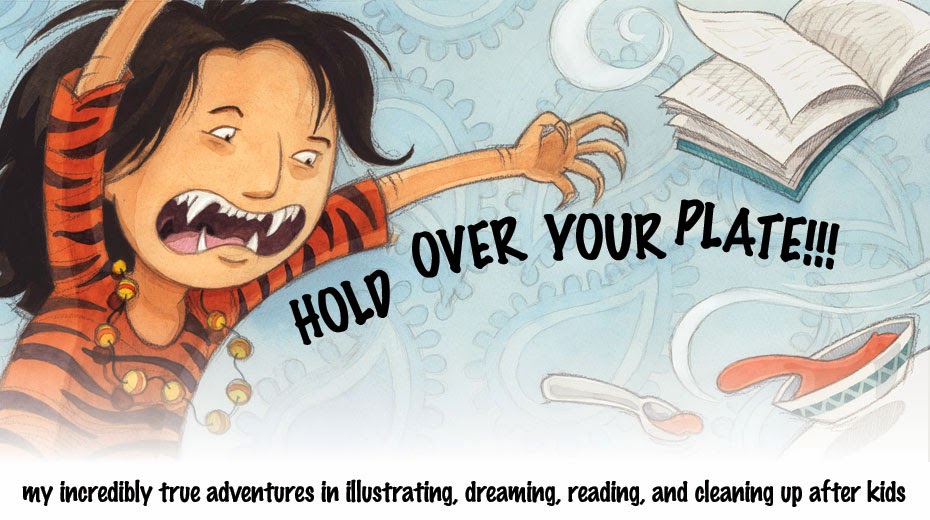For the article below, I researched the following sites:
theispot.com,
childrensillustrators.com,
folioplanet.com,
creativeshake.com (formerly portfolios.com) and
hireanillustrator.com. In addition to talking with members on their sites I sent a few questions to each site asking about how they promoted themselves and artists on the site. Dave Tabler of theispot.com (Ispot) and Darren DiLieto of hireanillustrator.com (Hai!) responded and their answers are below. I have also included some relevant responses from childrensillustrators.com that I received from an enquiry posted to them a year ago when I signed up.
How do you promote the site and how often?Hai!: we contact Art Directors and publishers directly, with Mailshot packs in the same way an agent would, but we are not an agency. 10-30 are sent out per week. The promo magazine (Hai!) is sent out frequently to all our contact and is published bi-annually. We do an open call to all members for inclusion, with 60 members making it into the mag.
Ispot: We've advertised theispot consistently with multi-page sections in Print and CA magazines for about 8 years now. We find the reach and shelf life of these magazines to far exceed anything we've accomplished with direct mail, which we still do occasionally, and we're able to get truly remarkable page rates from both publications. We also maintain an agile budget for international opportunities throughout the year. Any given month can find theispot ads in publications throughout the UK and EU, as well as Canada. For now, we are steering clear of Russia, China and India as they seem not to grasp the importance of intellectual property. When that changes we'll be there, too, as they represent a huge emerging opportunity. We've used the Google Adwords program since its inception, but are finding it to be somewhat bloated and overextended at this point. Similarly, mass emails are something we are much more wary of sending now that so many seem to be clogging inboxes lately.
Can you tell me where primarily most buyers on the site are(US or UK?) and in
what industry? What percentage are in the children's publishing industry?Hai!: It's about 50-50 UK, US. Mainly editorial and advertising, but we do contact a number of publishers (30% Children's).
Ispot: Our traffic analysis indicates that the vast majority of traffic on theispot has always come from the US, which suits this industry well because the budgets here tend to be stronger. As I mentioned above, that has not stopped us from making inroads into other markets, and foreign traffic spikes tell us when we've created really responsive advertising. Our reporting software does not tell us precisely which industries are using theispot the most heavily, and our privacy policy (a very important feature to buyers) prevents us from collecting that data from visitors on site. The nature of our promotion extends across all design industries, which is what makes it such an interesting buy for any type of illustrator. For example, artists who have always promoted themselves directly to specific markets such as travel or technology have been approached to illustrate for the children's market. The cross-pollination works both ways, which means that children's book illustrators on the site can be hired to create advertising artwork in
their signature style.
How do you promote new subscribers on the site?Ispot: Our "What's New" section features a slideshow that updates regularly with the newest artists on theispot. As soon as a new artist's work goes up, we take a look at the Portfolio to see if anything jumps out as being problematic (such as corrupt files or unreadable thumbnail cropping.) At the 3-month mark, one of our staff of analysts will take an in-depth look at the Portfolio to determine what is working well and how the weaker spots can be improved. The analysis includes keywording, image order, image presentation and suggestions for possible image replacement. The subscriber receives direct, personal feedback and advice with an eye to making sure that their work is presented in the best possible way and that it can be found easily by the people who can use it.
How do you choose who is in the illustrator spotlight on the homepage?Hai!: Once an illustrator as been on the site for a number of months, we then make random selection for the Q and A spotlight.
Ispot: Each illustrator is entitled to have an image in random rotation on the homepage. They submit the file through their personal 'My Spot' account, and we format and upload the image manually to ensure that it presents that artist, and by extension theispot, in the best way possible.
Childrensillustrators: These are selected by our staff. All members are rotated on the homepage via the numerous image placements.
How do you choose which illustrators show up on the different parts of the site? Hai!: The large and small images on the front page are random, the bottom left list is newest members, the illustrators page is last updated first and the show all illustrators list is alphabetical.
Ispot: The 'My Spot' section also has a Submit News option. We encourage subscribers to keep us up to date on projects, awards and other professional achievements. These can be posted up in
What's New,
Art News and
theispot blog with links back to the artist's Portfolio to encourage additional traffic from as many sources as possible. We're proud to promote these parts of theispot, as they are a real testament to the power of good illustration.
Childrensillustrators: This is something we work hard on. Childrensillustrators.com employ several different methods of distributing traffic. The homepage rotates all members at random. Our talent pool acts in much the same way. The style / subject & medium galleries help the visitor to define their search. Our advanced search tool has a number of different options to assist the busy art buyer. The newsletter highlights recent projects our members have been working on. The portfolio directory can be sorted by alphabetical listing, geographic location, recently updated portfolios and new members. The published books section provides yet another access point, distributing traffic and presenting a range of illustrators.
Are there any kind of back-end tools to manage the profile i.e. can track how often images are viewed, what keywords are getting click-thrus to images?Hai!: We don't use stats as they are misleading, because on any illustration site the main audience is other illustrators, no matter how hard we try to promote it to commissioning clients. So we rely on getting commissions being the only way to measure the success of the site.
Ispot: Yes, we have sophisticated tracking built into theispot to log traffic within the site as well as an option to apply Google Analytics to each Portfolio to gain perspective on a different set of data. Buyers, too, have accounts with tools that allow them to bookmark and track their favorite artists on the site, create and share lightboxes and license images from the Stock part of the site.
Do you offer any other services besides a portfolio subscription i.e. stock art portfolio, mailing list discounts, gallery sales etc.?Ispot: Theispot has a rights-managed stock section where artists archive their work for licensing and reuse. We have fought hard to maintain pricing as close to assignment as possible so that this section of the site actually allows the artists' past work to support their commission careers rather than compete against them. Our strategic partnership with AdBase custom list services offers ispot subscribers a 15% discount on their scrupulously maintained mail and email database. And we encourage all of our artists to buy Tad Crawford's excellent book & CD combination, "Business and Legal Forms for Illustrators;" ispot subscribers are entitled to a 50% discount.




